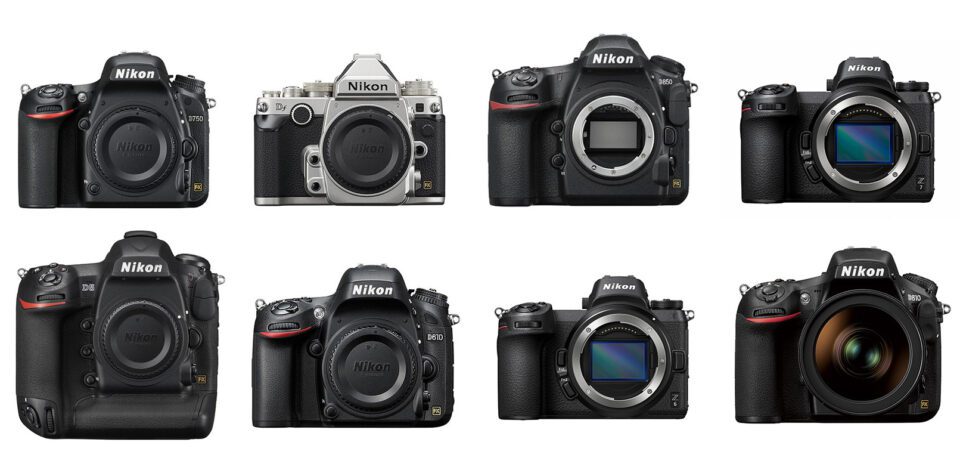
Nikon has been making full-frame digital cameras for almost 15 years, and their overall lineup today can seem overwhelming. In this article, I’ll compare Nikon’s entire full-frame (FX) camera lineup and explain which of these cameras might be a good choice for your photography. This list includes every full-frame digital camera that Nikon has ever made, including those which are now discontinued.
The point of this article is to give non-Nikon or first-time Nikon photographers a bird’s-eye view of the available FX Nikon cameras today (and those which the company used to make). You can also ask me in the comments section below if you have any questions, because, for space constraints, I couldn’t exactly write a full review of a dozen cameras here!
If you’re not just looking for full-frame cameras, but all Nikon cameras, we have a guide to that too. This one goes into more detail, though, especially on some discontinued but still very good full-frame Nikon DSLRs.
What Is a Full-Frame (FX) Camera?
A full-frame camera is any camera with a sensor of similar size to 35mm film. A full-frame sensor’s dimensions are roughly 24 × 36 mm in size.
Nikon labels its full-frame cameras as “FX” cameras. This is in comparison to the company’s smaller, 1.5× crop-sensor “DX” cameras, and extremely small 2.7× crop-sensor “CX” cameras.
Currently, FX cameras have the largest sensors of any Nikon camera. They are the company’s highest-end DSLR and mirrorless cameras.
The current Nikon lineup includes eleven current full-frame cameras – six DSLRs and five mirrorless. However, there are also ten discontinued FX digital cameras from Nikon (not counting variations like the D800E and D810A), bringing your total options to twenty-one if you know you want a Nikon full-frame camera.
The purpose of this article is to give an overview of all 21 full-frame Nikon cameras ever produced, especially the ones that are currently sold new.
Note that this article only compares Nikon’s full-frame digital cameras. If you want to see a similar comparison of all current Nikon cameras, go to this page instead.
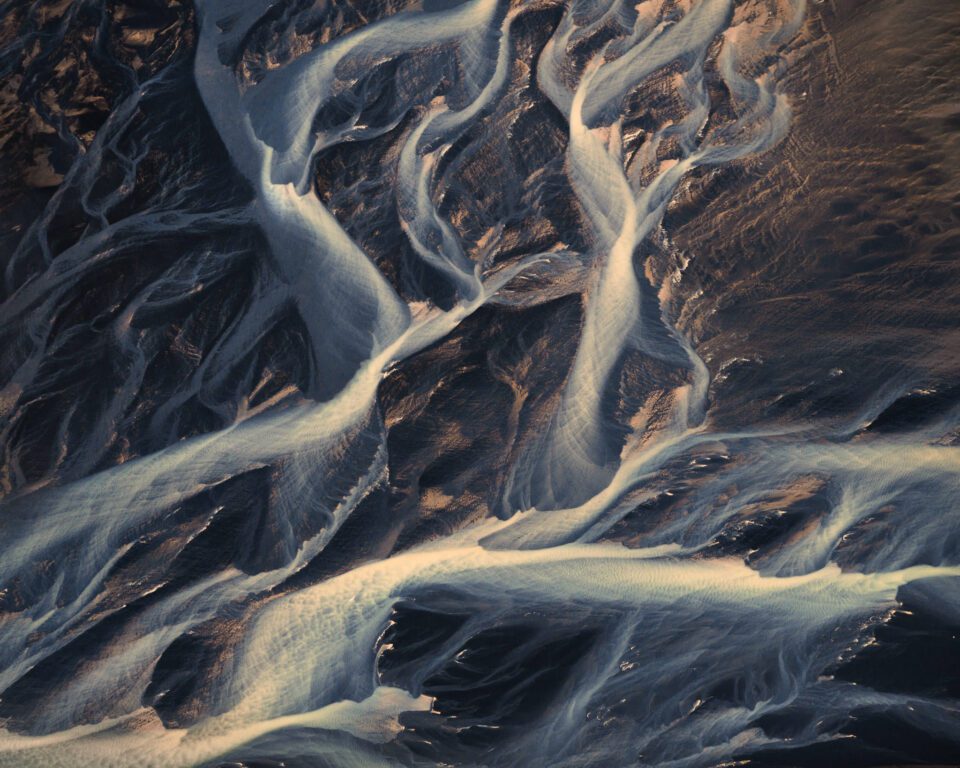
Taken with the Nikon D800e, a discontinued Nikon FX camera with excellent image quality
DSLR vs Mirrorless
Right now, Nikon is pouring a ton of energy into its full-frame mirrorless lineup. However, they have such a long history of making DSLRs that the DSLR lineup is arguably more refined at this point.
In terms of image quality, there is no difference between Nikon’s DSLR and mirrorless FX cameras. They’re all excellent. Instead, the mirrorless/DSLR differences are more subtle:
- Mirrorless advantages: Smaller and lighter, more modern features, electronic viewfinder, and access to an amazing lineup of Nikon Z mirrorless lenses.
- DSLR advantages: Better value, better autofocus system, optical viewfinder, tried-and-tested design, and access to a much larger lineup of native lenses.
If you’re still not sure, here’s a rough guideline: Nikon’s mirrorless cameras are better for travel photography right now, and arguably better for landscapes as well. For portraiture and event photography, there are pros and cons to both systems, and neither is necessarily ahead. For dedicated wildlife and action photography, Nikon’s DSLRs still have the advantage today, although the gap is narrowing.
Nikon Full-Frame DSLRs
Nikon D610
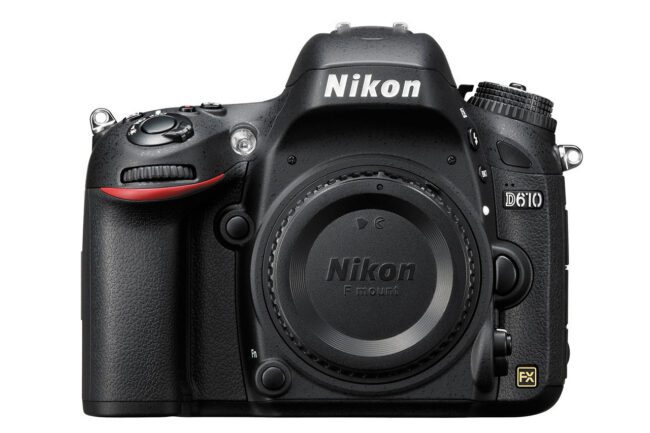
The lowest-end FX DSLR in Nikon’s current lineup is the $1300 Nikon D610 (current price here).
This camera is often overlooked today. There’s a good chance that even Nikon wants you to forget it exists. After all, it was only released to sweep the D600 dust issue under the rug.
Even worse, it currently sells for exactly the same price as the newer, higher-end Nikon D750. There is no good reason why someone would buy the D610 rather than the D750 at the same price.
Used, however, the D610 is much more reasonable. I often see it go for $700 or less at FredMiranda and eBay – an excellent deal for a 24-megapixel full frame camera. For anyone on a budget, a used D610 with a good lens is really hard to beat.
Specifications:
- Sensor size: FX
- Resolution: 24.3 megapixels
- Autofocus points: 39
- Frame rate: 6 FPS
- Base ISO: 100
- LCD type: Fixed, non-touchscreen
- Max video specs: 1920×1080, 30p
- Battery life: 900 photos
- Control layout: Advanced
- Memory cards: 2 SD
- Weight w/ battery and card: 850 g (30.0 oz)
- Dimensions (W×H×D): 141 × 113 × 82 mm (5.6 × 4.5 × 3.2 in.)
- Price: $1500 (body only)
- Announced: October 2013
The biggest liability is autofocus. The D610 has Nikon’s old 39-point focusing system (same as the entry-level D5600).
On the flip side, the D610’s biggest selling point is its sensor. 24 megapixels is ideal for many requirements – more than enough detail for any reasonable prints, yet significantly smaller file sizes than you’ll get from a 45-megapixel camera.
So, who should get the Nikon D610? At the moment, if you’re buying new, no one. It’s the same price as the D750, a better camera. But if you’re buying used, it’s an excellent choice for anyone who prioritizes image quality over autofocus prowess. Specifically, landscape and portrait photographers on a budget will find the D610 hard to beat.
Pros:
- Advanced controls and significant customization options
- Amazing full-frame image quality
- 24 megapixel sensor is the optimal for many photographers
- Excellent prices on the used market
Cons:
- Bought new, the same price as the D750, a more advanced camera
- 39-point autofocus system is outdated for fast action work
- Few advanced features: No touchscreen, non-tilting rear LCD, shutter speed limit of 1/4000 second, flash sync limit of 1/200 second
- No 4K or 1080p 60 FPS video
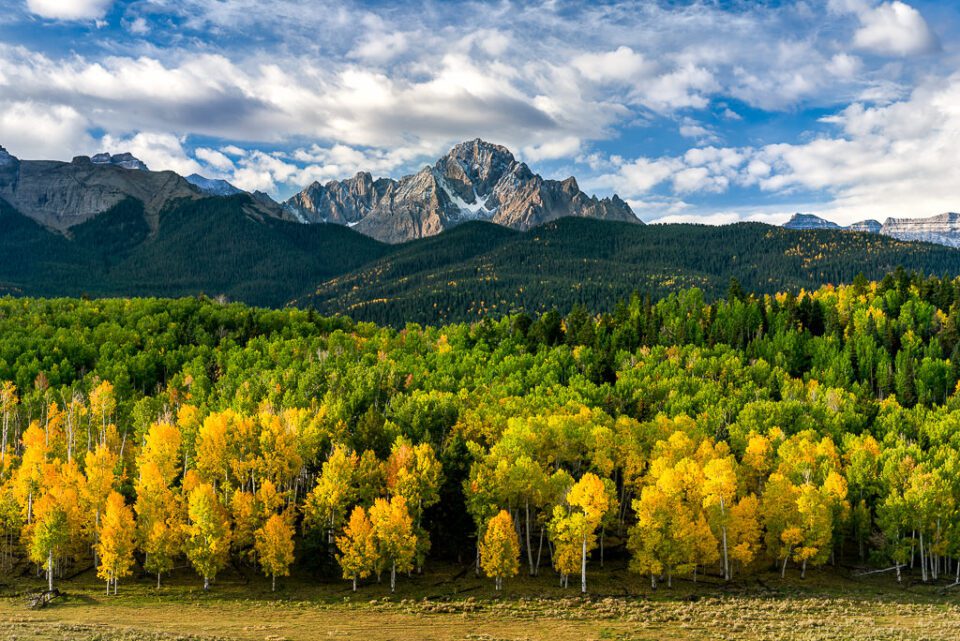
Nikon D750
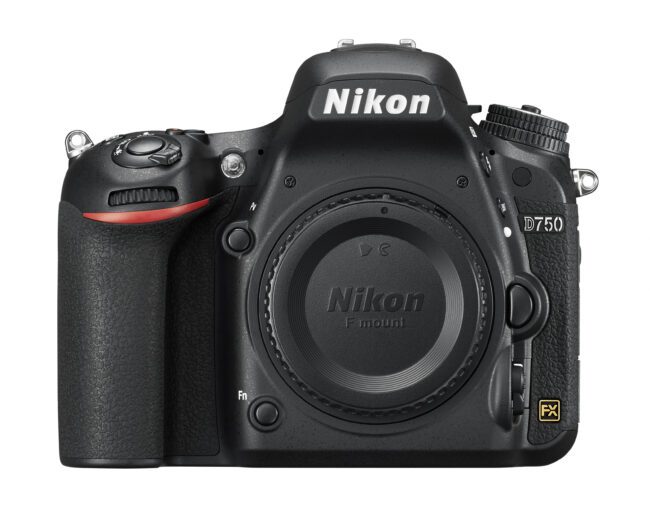
One of Nikon’s best all-around cameras is the Nikon D750, although note that it has since been replaced by the Nikon D780. (Nikon is still selling it new for the time being, although that probably won’t last long.)
The Nikon D750 is $1500 new (check current price), which is a bit overpriced considering some of the other Nikon full-frame cameras out there. Used, though, you can find it for around $850 – an excellent deal.
Here are the D750’s specs:
- Sensor size: FX
- Resolution: 24.3 megapixels
- Autofocus points: 51
- Frame rate: 6.5 FPS
- Base ISO: 100
- LCD type: Tilting, non-touchscreen
- Max video specs: 1920×1080, 60p
- Battery life: 1230 photos
- Control layout: Advanced
- Memory cards: 2 SD
- Weight w/ battery and card: 840 g (29.6 oz)
- Dimensions (W×H×D): 141 × 113 × 78 mm (5.6 × 4.5 × 3.1 in.)
- Price: $1500 (body only)
- Announced: September 2014
Compared to the D610, the D750 has a more advanced autofocus system, 60 FPS video (rather than 30 FPS), a tilting LCD, and slightly better battery life. Image quality is the same.
What are the D750’s drawbacks? As good of a camera as it is, it’s definitely starting to show its age. The 24 megapixel sensor is a bit behind Nikon’s newest 24 megapixel sensors at high ISOs. It lacks features like a touchscreen, 4K video, and some miscellaneous additions like focus-stack shooting. None of these issues are particularly big, and I’d encourage first-time Nikon shooters on a budget to look seriously at a used D750.
The D750’s biggest audience is probably the portrait/wedding crowd, but it’s quite solid for landscapes and even wildlife. If you want to dabble in a lot of genres without breaking the bank, it could be the right choice for you.
Pros:
- Advanced controls and significant customization options
- Amazing full-frame image quality
- Tilting screen
- Great 51-point autofocus system
- Solid value at $1500 new, amazing value used for around $850
Cons:
- No touchscreen
- No 4K video
- None of Nikon’s newest features, since it was released in 2014
- Given that it is a jack-of-all-trades camera, some specialized Nikon cameras are better for specific uses like sports or landscapes
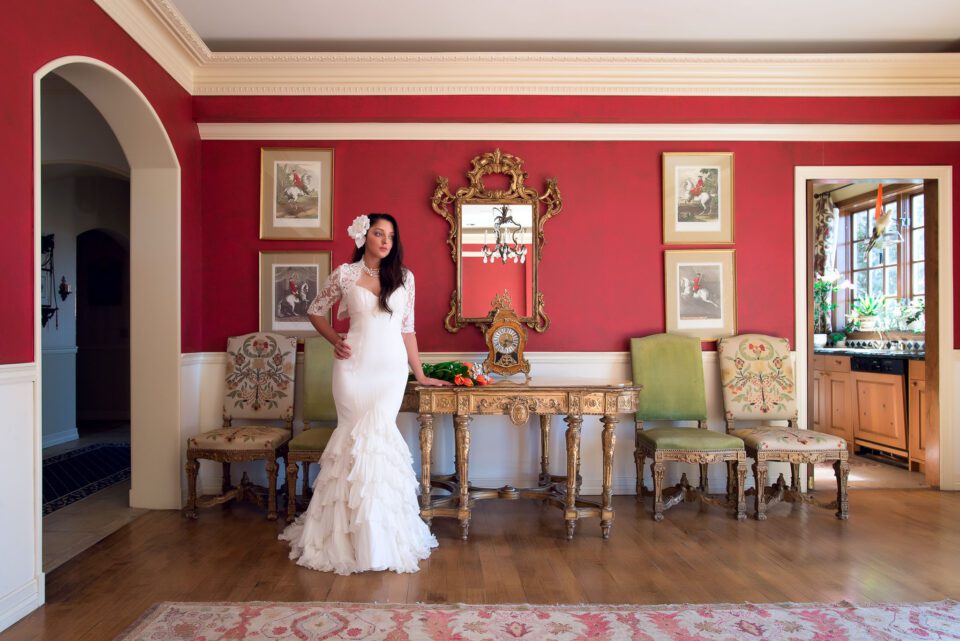
Nikon D780
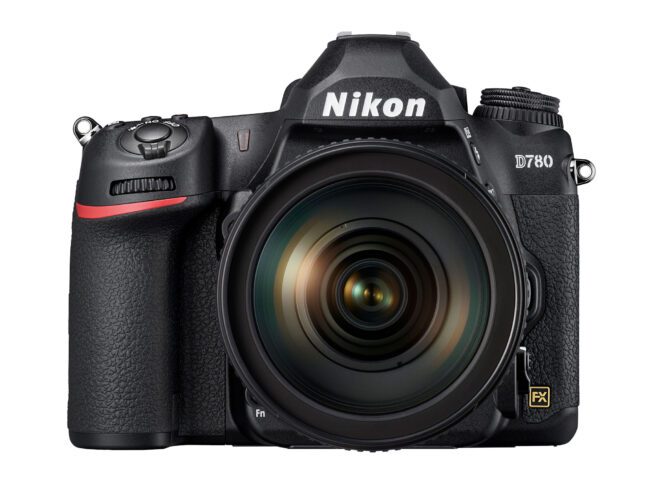
The camera that replaced the Nikon D750 is called the D780, and it has some fantastic features. To be specific, it fixes almost all of the Nikon D750’s issues and adds some of Nikon’s newest (mirrorless-inspired) tech. The Nikon D780 is currently selling for about $2300 new (check current price) and $1700 used. Here are the specs:
- Sensor size: FX
- Resolution: 24.5 megapixels
- Autofocus points: 51
- Frame rate: 7 FPS mechanical shutter, 12 FPS in live view with electronic shutter and 12-bit RAW
- Base ISO: 100
- LCD type: Tilting touchscreen
- Max video specs: 4K up to 30 FPS, 1080p up to 120 FPS
- Battery life: 2260 photos
- Control layout: Advanced
- Memory cards: 2 SD, UHS-II compatible
- Weight w/ battery and card: 840 g (29.6 oz)
- Dimensions (W×H×D): 143.5 × 115.5 × 76.0 mm (5.6 × 4.5 × 3.0 inches)
- Price: $1500 (body only)
- Announced: January 2020
Compared to the D750, the Nikon D780 has a touchscreen, 4K video, marginally better image quality at high ISOs, and many of Nikon’s newest bells and whistles. These include things like extended 900 second shutter speeds, focus stack shooting, and better live view autofocus.
For portrait or wedding photographers who want Nikon’s best all-around camera at the moment, the Nikon D780 is the way to go. It’s a bit newer than most of Nikon’s cameras, so it isn’t selling as cheap as some of the others, but the price premium isn’t without good reason. The D780 is an excellent camera.
Nikon could have technically bumped up some of the D780’s “top-line” specs like the sensor resolution and maximum frame rate, but other than that, there’s almost nothing to complain about with this camera. If you want a jack-of-all-trades DSLR, the D780 is the way to go.
Pros
- Advanced controls and significant customization options
- Amazing full-frame image quality
- Tilting touchscreen
- Great 51-point autofocus system
- Most of Nikon’s newest features, borrowed from Nikon’s mirrorless lineup
- Fixes almost all the major problems of the Nikon D750
Cons
- A bit on the pricy side because it’s relatively new, at $2300 body-only
- Despite six years since the D750, the D780 still has “only” 24 megapixels and has bumped up the frame rate via the viewfinder by just 0.5 FPS (from 6.5 to 7 FPS)
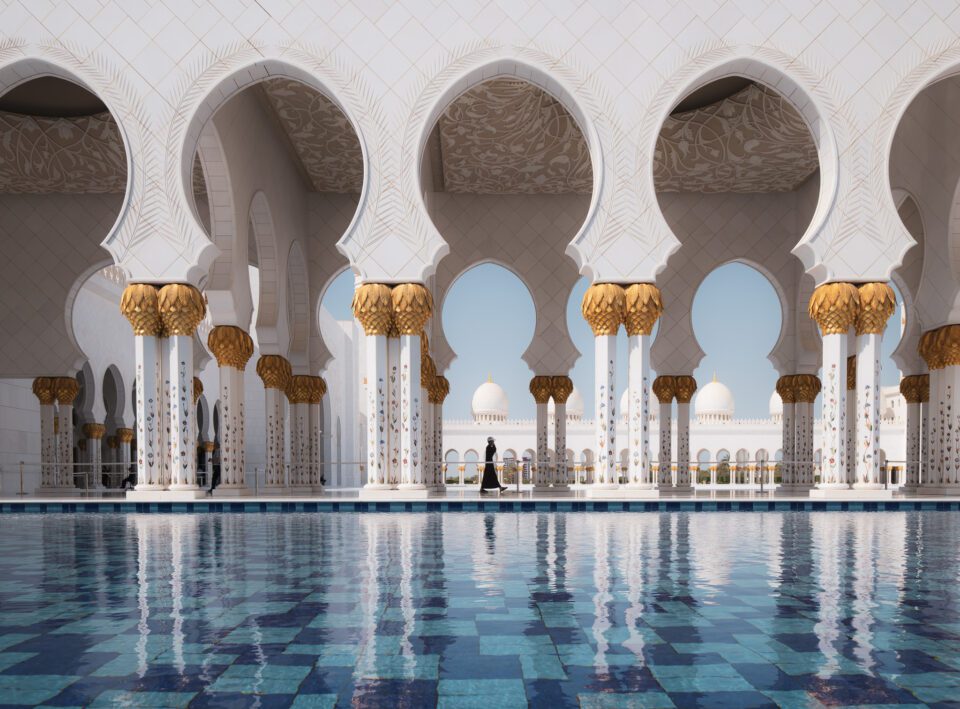
Nikon Df
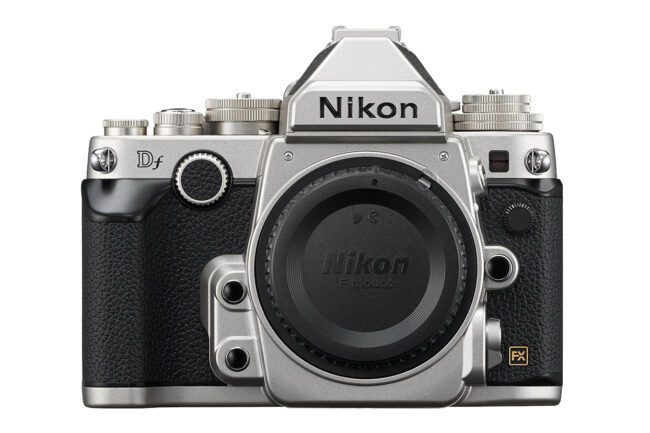
This $2750 retro-themed DSLR is a bit of a weird one, but it has a dedicated following even today. Here are the Nikon Df’s specifications, which may remind you of the D610 more than something so expensive:
- Sensor size: FX
- Resolution: 16.2 megapixels
- Autofocus points: 39
- Frame rate: 5.5 FPS
- Base ISO: 100
- LCD type: Fixed, non-touchscreen
- Max video specs: No video capabilities
- Battery life: 1400 photos
- Control layout: Professional, retro
- Memory cards: 1 SD
- Weight w/ battery and card: 765 g (27.0 oz)
- Dimensions (W×H×D): 144 × 110 × 67 mm (5.7 × 4.3 × 2.6 in.)
- Price: $2750 (body only)
- Announced: November 2013
The Nikon Df is a beautifully-designed camera with excellent manual controls. Plus, in low light, its 16-megapixel sensor has slightly better high ISO performance than any other Nikon camera at the moment.
Then again, for $2750 new, it’s a tough sell (current price here). The used market clearly recognizes that, too; I’ve seen it go as low as $1000, although $1200 or so is more typical.
It’s important to mention that Nikon doesn’t have any real duds in its lineup – just a couple cameras that are more expensive than they should be, when purchased new. The Df is one of them.
That said, it ticks the right boxes for certain photographers, and anyone who’s willing to buy used can get quite a good deal on the Df. If nothing else, this camera certainly holds a unique spot in Nikon’s lineup.
The Df is not really aimed at landscape photographers (because of the 16 megapixel sensor) or sports photographers (because of the 39 point autofocus system). But for portraiture, weddings, and event photography, there’s a serious case to be made for this camera’s quality. Just… don’t buy it new. The $2750 price is pretty outrageous.
Pros:
- Beautiful design and pro-level retro controls
- Best-in-class high ISO performance for a full frame camera
- Nikon’s lightest FX DSLR
- Exposure meter coupling with pre-Ai Nikon lenses
- Used prices of $1000-1200 are quite reasonable
Cons:
- Old 39-point autofocus system
- No video capabilities at all
- Single memory card slot
- Limited to 5.5 FPS, the lowest of any Nikon FX camera
- 16 megapixel sensor is lowest in Nikon’s lineup (though some consider this a benefit)
- Few advanced features: No touchscreen, non-tilting rear LCD, shutter speed limit of 1/4000 second, flash sync limit of 1/200 second
- Overpriced when sold new at $2750
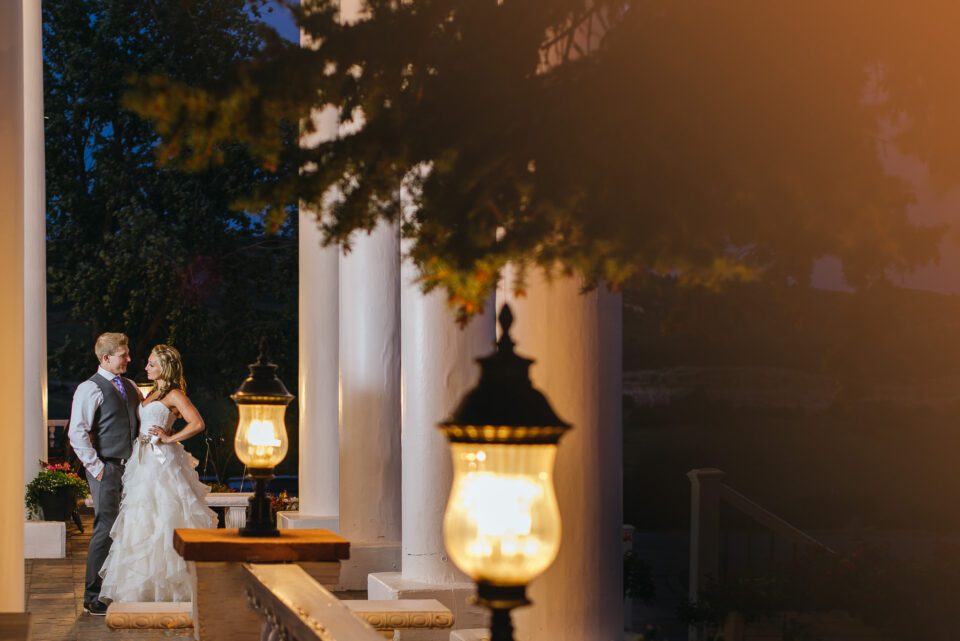
Nikon D850
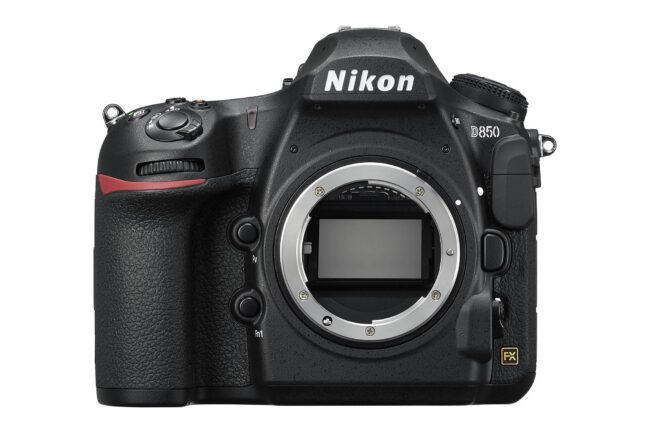
Next up is one of the best cameras of all time, the Nikon D850. We ranked it #1 in our list of today’s top DSLR cameras, with good reason. This $3000, 45-megapixel FX camera is a monster.
The specs:
- Sensor size: FX
- Resolution: 45.7 megapixels
- Autofocus points: 153
- Frame rate: 7 FPS, or 9 FPS when using Nikon’s battery grip
- Base ISO: 64
- LCD type: Tilting touchscreen
- Max video specs: 3840×2160 (4k), 30p
- Battery life: 1840 photos
- Control layout: Professional
- Memory cards: 1 SD, 1 XQD
- Weight w/ battery and card: 1005 g (35.5 oz)
- Dimensions (W×H×D): 146 × 124 × 79 mm (5.8 × 4.9 × 3.1 in.)
- Price: $3000 (body only)
- Announced: July 2017
It has Nikon’s top 153-point autofocus system, the company’s highest resolution 45-megapixel sensor, a surprisingly high frame rate of 7 FPS (9 FPS with the battery grip), and nearly every one of Nikon’s top features. The D850 commands a $3000 price for good reason (check the current price here).
Then again, $3000 is a lot of money to spend on a camera, no matter how good it is. Used, the D850 is still a hefty $2200 or so on sites like eBay. For that price, you could get two D750s and still have room to spare for a lens.
In general, I’d say photographers would be better off with the D750 coupled with a good lens. But if you want the best of the best, you know where to look.
- The Nikon D850 got 4.9 out of 5 stars in our review, the highest of any camera yet
- Here, we explain our recommended camera settings to get as much as possible out of the D850
At first glance, the Nikon D850 may look like it’s targeted at landscape photographers. However, plenty of sports and wildlife photographers will find the 153-point autofocus system and 9 FPS shooting (with battery grip) to be ideal for their needs. Unless light weight is your top requirement, the D850 is as close to perfect as any camera today.
Pros:
- Pro-level build quality, controls, and customization options
- Best-in-class image quality with 45 megapixel sensor and base ISO 64
- Surprisingly good 7 FPS shooting (9 FPS with battery grip)
- Nikon’s best autofocus system, 153 points
- Tilting touchscreen
- 4K video
Cons:
- Expensive at $3000 (around $2200 used), though you get what you pay for
- Larger and heavier than most other Nikon cameras
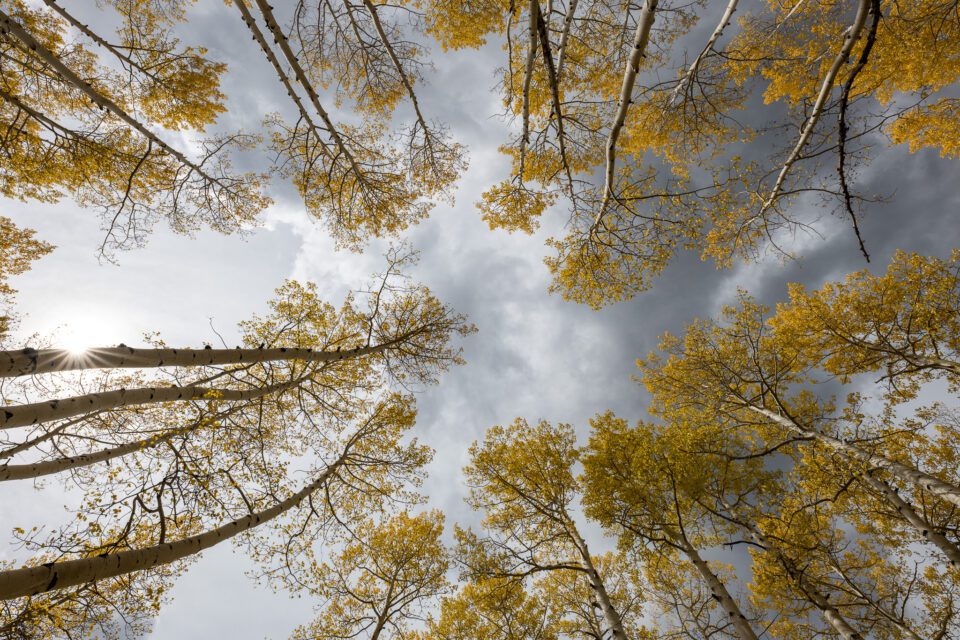
Nikon D6
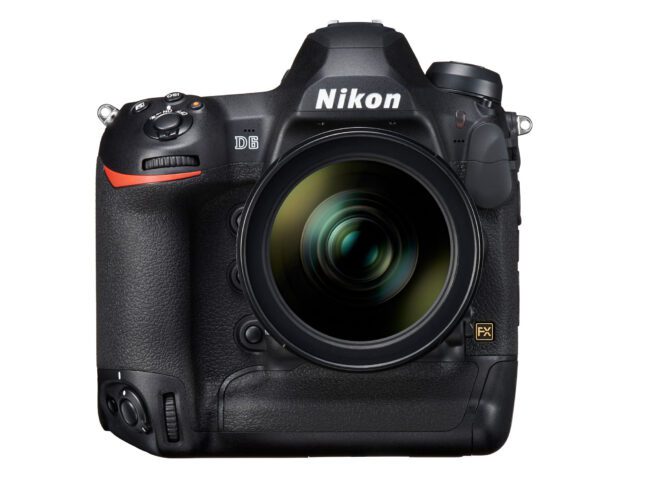
As amazing as the Nikon D850 is, it’s still not the flagship camera in Nikon’s lineup. That honor goes to the $6500 Nikon D6 – an extreme sports and action camera with Nikon’s top autofocus system, a 14 FPS maximum frame rate, and a 20 megapixel FX sensor.
The D6 is the only camera from Nikon to have a 105-point autofocus system where all 105 points are cross-type. The result is that it’s amazing for tracking action in low light even outside the center of the frame. Not to mention the practically indestructible build quality. As expensive as it is, the D6 will still find plenty of support among action photography pros.
Here are the D6’s specifications:
- Sensor size: FX
- Resolution: 20.8 megapixels
- Autofocus points: 105, all cross-type
- Frame rate: 14 FPS
- Base ISO: 100
- LCD type: Fixed touchscreen
- Max video specs: 3840×2160 (4k), 30p
- Battery life: 3580 photos
- Control layout: Top-tier professional
- Memory cards: 2 CF Express
- Weight w/ battery and 2 cards: 1440 g (3.17 lbs)
- Dimensions (W×H×D): 160.0 x 163.0 x 92.0mm (6.3 × 6.4 × 3.6 in.)
- Price: $6500 (body only)
- Announced: February 2020
As amazing as the Nikon D6 is, it’s also so specialized that many photographers don’t even have it on their radar. If you told me I had $6000 to spend on a Nikon camera, I’d buy a D850 or Nikon Z7 II and put the rest of the money toward lenses.
Of course, if you need it, you need it. You probably already have it, and you’ll pre-order the D7 the moment it’s announced.
Pros:
- Best-in-class build quality, controls, and customization options
- Best-in-class high ISO performance
- 14 FPS shooting and 200 image buffer
- Nikon’s best autofocus system
- Rear LCD is touchscreen, though non-tilting (to improve build quality)
- 4K video
Cons:
- Nikon’s most expensive camera at $6500
- Extremely large, heavy, specialized DSLR
Nikon Full-Frame Mirrorless Cameras
Nikon Z6
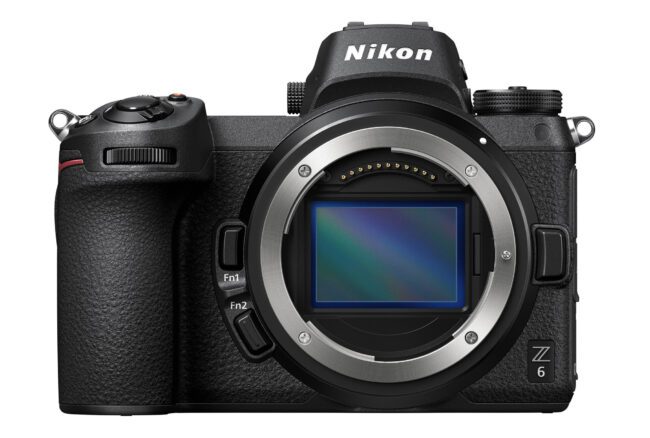
It took the company years to get here, but in 2018 Nikon finally released a series of full-frame mirrorless cameras to compete with the likes of Sony. Although the Z6 has been superseded by the Nikon Z6 II, Nikon is still selling it new as of 2021.
The Nikon Z6 sells for a competitive $1800 new, though Nikon’s been dropping prices; check current price here. In terms of specifications, the Nikon Z6 is quite good:
- Sensor size: FX
- Resolution: 24.5 megapixels
- Autofocus system: 273-point hybrid PDAF
- Frame rate: 12 FPS (12-bit RAW), 9 FPS (14-bit RAW)
- Base ISO: 100
- LCD type: Tilting touchscreen
- Max video specs: 3840×2160 (4k), 30p
- Battery life: 310 photos
- Control layout: Professional
- Memory cards: 1 XQD
- Weight w/ battery and card: 675 g (23.8 oz)
- Dimensions (W×H×D): 134 × 101 × 68 mm (5.3 × 4.0 × 2.7 in.)
- Price: $1800 (body only)
- Announced: August 2018
Note the weight of the Z6: 675 grams (1 lb, 7.8 oz). By comparison, the Nikon D780 weighs 840 grams (1 lb 13.7 oz). Even the Df, Nikon’s lightest FX DSLR, is 90 grams (3.2 oz) heavier than the Z6. This is one of the big advantages of mirrorless cameras over DSLRs.
In addition, the Z6 has Nikon’s new Z lens mount, allowing you to use the camera with any of Nikon’s excellent mirrorless lenses. And you can still use Nikon’s existing DSLR lenses (the F-mount glass) on the Z6, by using Nikon’s FTZ adapter. Though, when you do, you’ll lose a decent bit of the Z6’s weight savings compared to DSLRs.
The Nikon Z6’s closest DSLR competitor is the Nikon D780. The two are actually extremely similar, but the Z6 has the expected benefits of a mirrorless camera, such as light weight, an excellent electronic viewfinder, and in-body image stabilization. The D780 has dual memory card slots, a better battery life, and a slightly better autofocus system. The two cameras have the exact same image quality. See our D780 vs Z6 comparison for more details.
What about focusing? Although the Z6’s autofocus system has a whopping 273 focusing points, it’s not as good as Nikon DSLRs for tracking moving subjects. (Interestingly, for photographing nonmoving subjects, the Z6 is actually slightly faster and more accurate to focus than Nikon DSLRs.)
Overall? Travel photographers and videographers will love it, while I’d stick to the D780 for portrait and event photography because of the better autofocus tracking. But you can’t go wrong either way.
The Z6 also sells for remarkably good prices on the used market – we’ve seen it as low as $1150 at sites like Fred Miranda and KEH. At that price, it’s almost impossible to beat.
Pros:
- Pro-level build quality, controls, and customization options
- Best-in-class high ISO performance
- Tilting touchscreen
- Nikon’s newest features, including in-body image stabilization
- 4K video with excellent specifications
- Small and lightweight
- Good value new at $1800, with used prices even better
- Surprisingly good 12 FPS limit in 12-bit RAW and 9 FPS in 14-bit RAW
- Access to Nikon’s newest mirrorless lenses
Cons:
- Autofocus system, though excellent for nonmoving subjects, struggles with tracking fast action
- Single memory card slot
- Requires an adapter to use F-mount lenses
- Battery life of just 310 photos with the EVF (though this isn’t worse than typical Nikon DSLRs, when the DSLR is used in live view only)
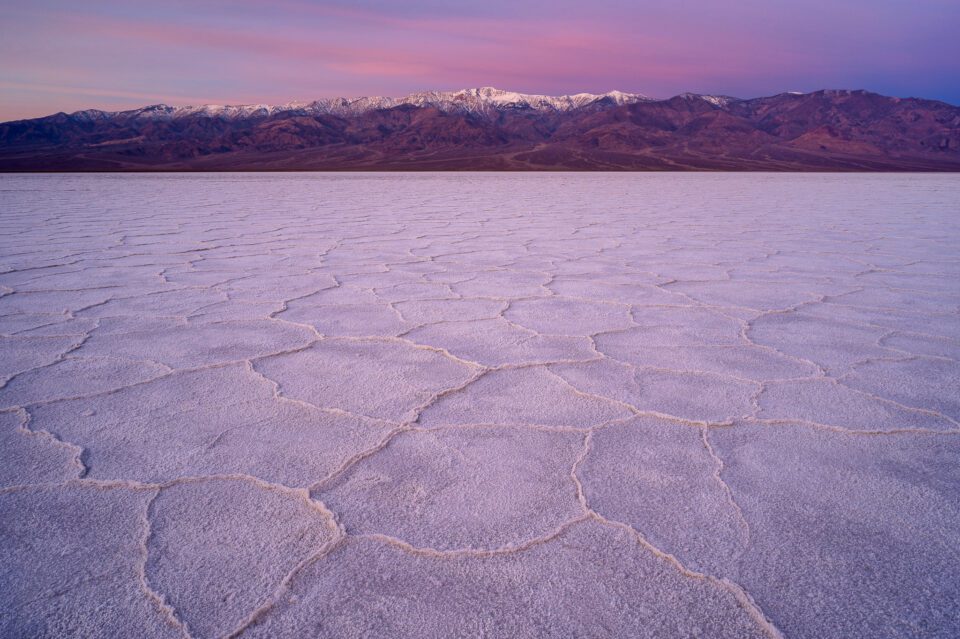
Nikon Z6 II
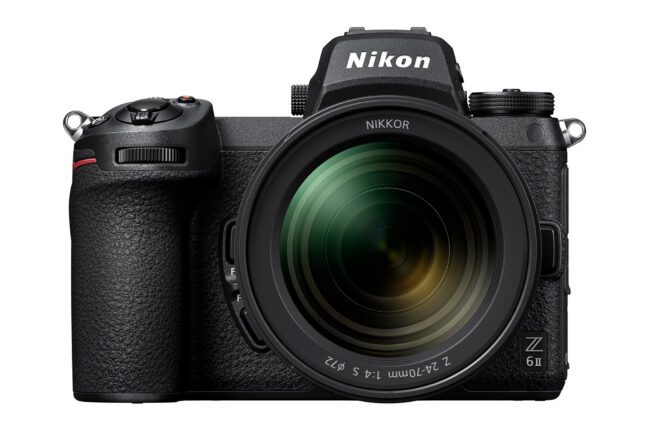
Despite all the Nikon Z6’s great points, it’s still showing its age a bit given that it was part of Nikon’s first generation of Z-series mirrorless cameras. Since then, Nikon has released the Z6 II, which fixes some of the Nikon Z6’s biggest flaws (and is probably responsible for most of the Z6’s amazing used prices)!
Here are the Z6 II’s key specifications:
- Sensor size: FX
- Resolution: 24.5 megapixels
- Autofocus system: 273-point hybrid PDAF
- Frame rate: 14 FPS (12-bit RAW), 10 FPS (14-bit RAW)
- Base ISO: 100
- LCD type: Tilting touchscreen
- Max video specs: 3840×2160 (4k), 60p
- Battery life: 340 photos
- Control layout: Professional
- Memory cards: 1 CF Express, 1 SD (UHS-II compatible)
- Weight w/ battery and card: 705 g (1.55 lbs)
- Dimensions (W×H×D): 134 × 101 × 70 mm (5.3 × 4.0 × 2.8 in.)
- Price: $2000 (body only)
- Announced: October 2020
The Z6 II is currently selling for $2000, but you should check the current price here, because it’ll start selling for some good discounts once the newness fades away.
Compared to the Z6, the Z6 II adds some much-requested features like better autofocus tracking, dual memory card slots, and 4K video at 60 FPS. Its autofocus still isn’t perfect at tracking fast-moving subjects, but otherwise, it’s an all-around fantastic camera.
The only issue right now is price. Given that the Nikon Z6 II was announced so recently, it’s not possible to find it selling used at such competitive prices. But $2000 new is not bad at all, and actually puts the Z6 II cheaper than the Nikon D780, despite the Z6 II being the better camera in many ways.
Here are the camera’s pros and cons:
Pros:
- Pro-level build quality, controls, and customization options
- Best-in-class high ISO performance
- Tilting touchscreen
- Nikon’s newest features, including in-body image stabilization
- 4K video with excellent specifications, including 60 FPS for slow motion
- Small and lightweight
- Good value new at $2000
- Surprisingly good 14 FPS limit in 12-bit RAW and 10 FPS in 14-bit RAW
- Access to Nikon’s newest mirrorless lenses
- Dual memory card slots
Cons:
- Autofocus system, though excellent for nonmoving subjects, could be better at tracking fast action
- Requires an adapter to use F-mount lenses
- Battery life rated to just 340 photos with the EVF (though this isn’t worse than typical Nikon DSLRs, when the DSLR is used in live view only)
- Used prices are high at the moment because the camera is so new
Nikon Z7
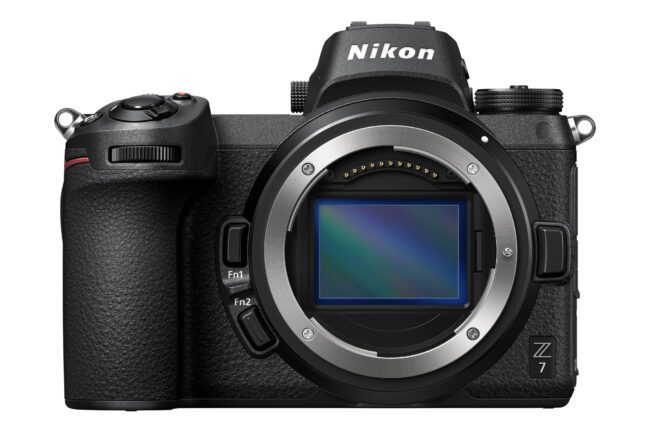
The high-resolution counterpart to the Nikon Z6 is the Nikon Z7. New, it’s currently selling for $2300, although that’s a temporary sale, and you may want to check the current price. (Used, the Z7 is around $1750). The Nikon Z7 has since been replaced by the Z7 II, but for now, Nikon is still selling it new.
Nikon Z7 specifications:
- Sensor size: FX
- Resolution: 45.7 megapixels
- Autofocus system: 493-point hybrid PDAF
- Frame rate: 9 FPS (12-bit RAW), 8 FPS (14-bit RAW)
- Base ISO: 64
- LCD type: Tilting touchscreen
- Max video specs: 3840×2160 (4k), 30p
- Battery life: 330 photos
- Control layout: Professional
- Memory cards: 1 XQD
- Weight w/ battery and card: 675 g (23.8 oz)
- Dimensions (W×H×D): 134 × 101 × 68 mm (5.3 × 4.0 × 2.7 in.)
- Price: $3000 (body only)
- Announced: August 2018
Other than slight differences here and there, the Nikon Z7 is the same as the Nikon Z6, just with a 45 megapixel sensor rather than 24 MP. They even have the same camera body and button layout. You can check our Z6 vs Z7 comparison to see how similar they really are.
My recommendation – and I say this as a Nikon Z7 owner – is to get the Z6. The extra megapixels are overkill for most photographers, and even a drawback for some (taking up twice the hard drive space).
Still, certain specialized photographers will find the Z7 a great camera for their needs. If you’re a landscape or architectural photographer who prints large, there’s no denying that the Z7 is a strong camera. In many ways, it’s like a mirrorless D850 – albeit not as refined of a camera overall. (For the more refined version, you’ll want to check out the Nikon Z7 II that’s up next.)
Pros:
- Pro-level build quality, controls, and customization options
- Best-in-class image quality with 45 megapixel sensor and base ISO 64
- Tilting touchscreen
- Nikon’s newest features, including in-body image stabilization
- 4K video with excellent specifications
- Small and lightweight
- Surprisingly good 9 FPS limit in 12-bit RAW and 8 FPS in 14-bit RAW
- Access to Nikon’s newest mirrorless lenses
Cons:
- Autofocus system, though excellent for nonmoving subjects, struggles with tracking fast action
- Single memory card slot
- Requires an adapter to use F-mount lenses
- Fairly expensive at $3000, or around $2400 used. Nikon D850 is similar in price, but with a better autofocus system and a larger native lens lineup
- Battery life of just 330 photos (though this isn’t worse than typical Nikon DSLRs, when the DSLR is used in live view only)
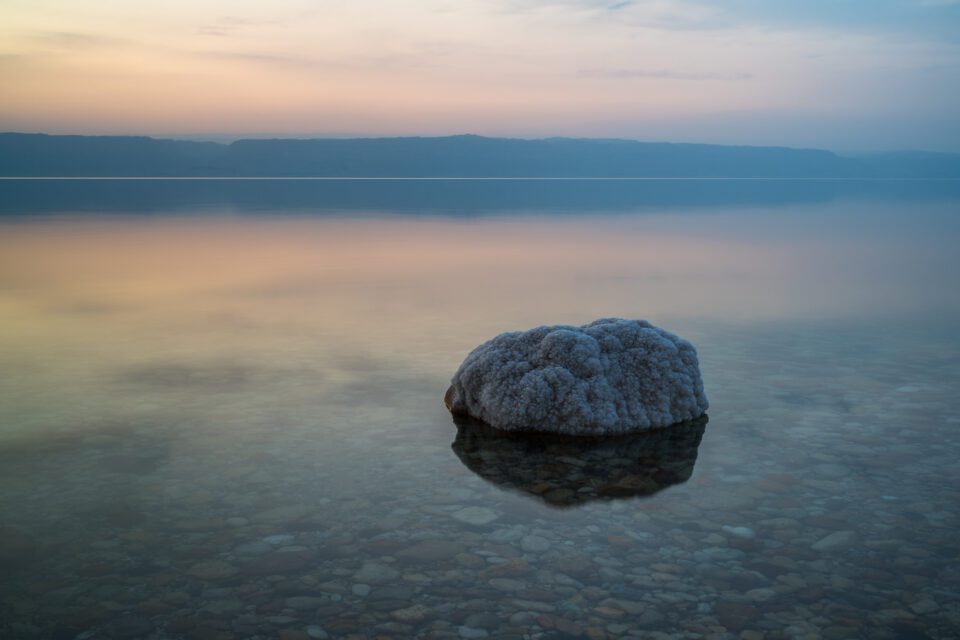
Nikon Z7 II
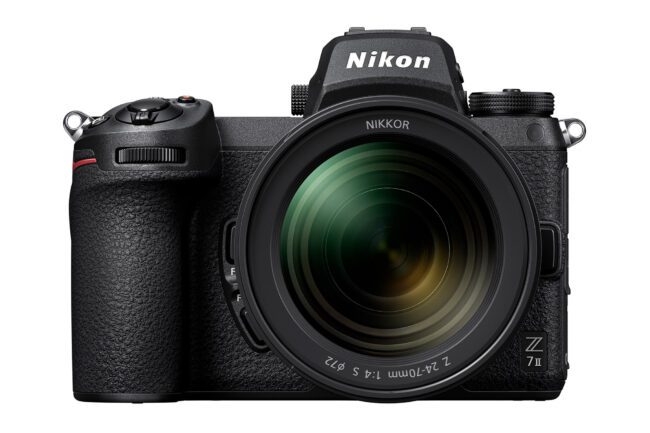
Nikon’s current top-of-the-line mirrorless camera is the Nikon Z7 II. It sells new for $3000 (check current price) and used for… well, about $3000, thanks to how new the camera is. (You can probably find it for $2800 or so if you look hard enough.)
Here are the Z7 II’s specifications:
- Sensor size: FX
- Resolution: 45.7 megapixels
- Autofocus system: 493-point hybrid PDAF
- Frame rate: 10 FPS (12-bit RAW), 9 FPS (14-bit RAW)
- Base ISO: 64
- LCD type: Tilting touchscreen
- Max video specs: 3840×2160 (4k), 60p
- Battery life: 360 photos
- Control layout: Professional
- Memory cards: 1 CF Express, 1 SD (UHS-II compatible)
- Weight w/ battery and card: 705 g (1.55 lbs)
- Dimensions (W×H×D): 134 × 101 × 70 mm (5.3 × 4.0 × 2.8 in.)
- Price: $3000 (body only)
- Announced: October 2020
As you can see, it’s very similar to the Nikon Z6 II, although it has a higher resolution sensor of 45 rather than 24 megapixels, and a base ISO of 64 rather than 100.
If that description sounds familiar, it’s because the Z7 II is also similar to the prior generation Z7. The two cameras share a sensor (and thus the same image quality) and have almost identical builds. The reason to get the Z7 II are for new features like a larger buffer, slightly better autofocus, dual memory card slots, and 4K video at 60 FPS.
It may seem like it’s not worth the money over the Z7, and maybe for you it’s not. But before you make that decision, you may want to check out our Nikon Z7 vs Z7 II comparison. Nikon made a lot of behind-the-scenes improvements on the Z7 II that make it a more comprehensive camera than the Z7.
Pros:
- Pro-level build quality, controls, and customization options
- Best-in-class image quality with 45 megapixel sensor and base ISO 64
- Tilting touchscreen
- Nikon’s newest features, including in-body image stabilization
- 4K video with excellent specifications, including 60 FPS for slow motion
- Small and lightweight
- Surprisingly good 9 FPS limit in 12-bit RAW and 8 FPS in 14-bit RAW
- Access to Nikon’s newest mirrorless lenses
- Dual memory card slots
Cons:
- Autofocus system, though excellent for nonmoving subjects, could be better at tracking fast action
- Requires an adapter to use F-mount lenses
- Used prices aren’t a significant discount yet, thanks to how recent the camera is
- Battery life of just 360 photos (though this isn’t worse than typical Nikon DSLRs, when the DSLR is used in live view only)
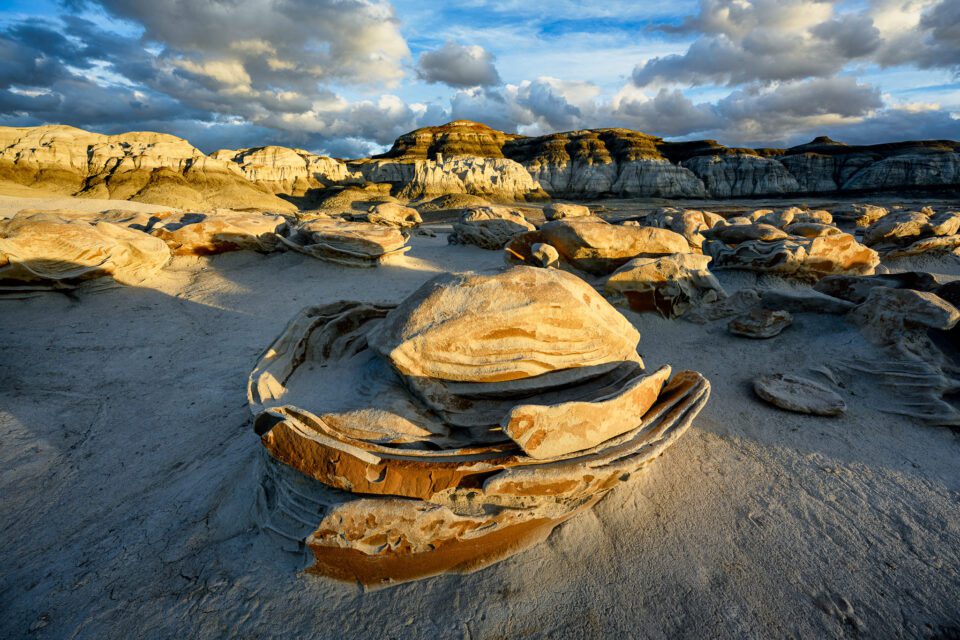
Nikon Z5
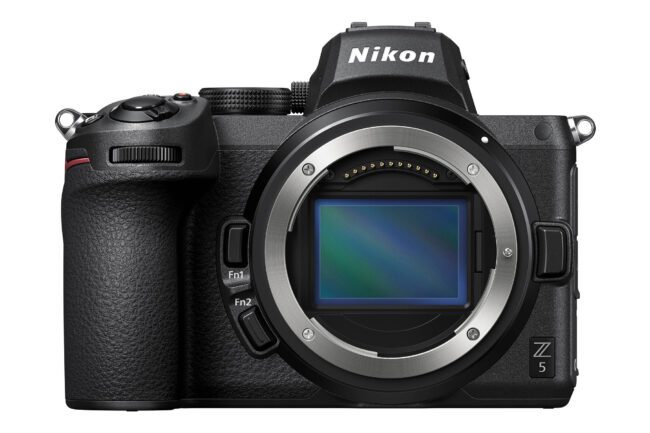
The least expensive full-frame camera in Nikon’s lineup (if bought new, at least) is the Z5. Depending on the sale, we’ve seen its new prices dip down as low as $1000, which is absurd for a camera that was released not that long ago in mid-2020. (Check current price here.) The Z5’s specifications are as follows:
- Sensor size: FX
- Resolution: 24.3 megapixels
- Autofocus system: 273-point hybrid PDAF
- Frame rate: 4.5 FPS
- Base ISO: 100
- LCD type: Tilting touchscreen
- Max video specs: 3840×2160 (4k), 30p, but with a 1.7x crop
- Battery life: 470 photos
- Control layout: Advanced
- Memory cards: 2 SD (UHS-II compatible)
- Weight w/ battery and card: 675 g (1.49 lbs)
- Dimensions (W×H×D): 134 × 101 × 70 mm (5.3 × 4.0 × 2.8 in.)
- Price: $1400 (body only), but frequently on sale for less
- Announced: July 2020
This camera is an amazing value, full stop. Compared to the much more expensive Nikon Z6 II – which is already a good value camera – the Z5 gives up some high-FPS shooting, loses the camera’s top-panel LCD, has a 1.7x crop in 4K video, and otherwise is basically the same.
While it does use a slightly older 24 megapixel sensor compared to the one on the Z6 II, the image quality differences are very small. Only at ultra-high ISOs will you notice any difference, and even then, only if you’re pixel-peeping.
Used, you might find the Z5 for about $800 – a great deal normally, although if it’s on sale for $1000 new, it’s probably better to go new. Either way, for photographers who want to get a full-frame camera with modern features at a low price, it’s hard to beat the Z5.
Pros:
- Advanced build quality, controls, and customization options
- Great 24 megapixel sensor with full-frame image quality
- Tilting touchscreen
- Nikon’s newest features, including in-body image stabilization
- Small and lightweight
- Access to Nikon’s newest mirrorless lenses
- Extremely good value, especially when on sale for $1000, or used for $800
Cons:
- Autofocus system, though excellent for nonmoving subjects, could be better at tracking fast action
- Low maximum frame rate of 4.5 FPS
- 4K video has a 1.7x crop, which can make it hard to film at wide angle focal lengths
- Requires an adapter to use F-mount lenses
- Battery life of just 470 photos (though this isn’t worse than typical Nikon DSLRs, when the DSLR is used in live view only)
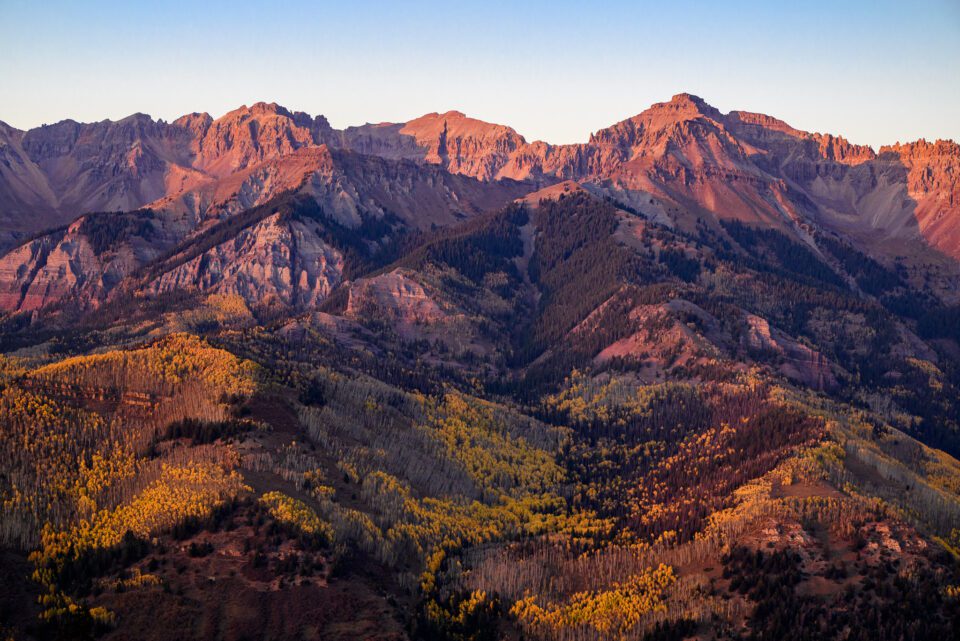
Discontinued FX Cameras
All the cameras above are current options in Nikon’s lineup, sold new. But there is also an extensive used market for older, discontinued Nikon full-frame cameras. Many of them remain excellent choices today:
Nikon D600
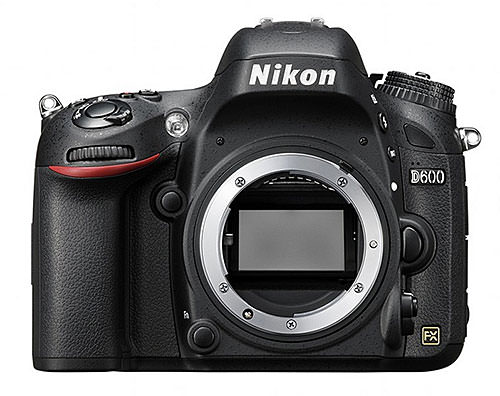
Predecessor of the D610, the D600 is probably Nikon’s most infamous DSLR. Although it was an excellent camera for the price in many ways, it had a common issue of oil and dust sticking on the sensor and harming photos. Nikon eventually recalled the D600, but you can still find used copies available on sites like eBay.
Because of the dust issue, the D600 sells for excellent prices on the used market. It’s practically identical to the D610 in specifications – the biggest difference is that it shoots 5.5 FPS rather than 6 FPS.
Used, the D600 is about $500 or even less. This is actually an amazing deal considering that most people got the oil and dust issue fixed, since Nikon offered such a service for free until January of 2020.
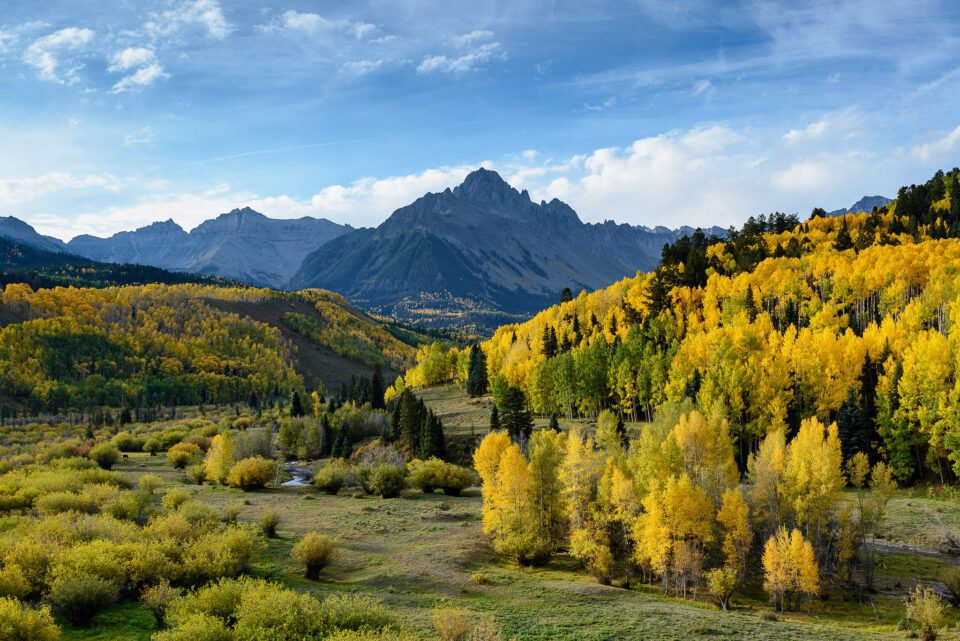
Nikon D700
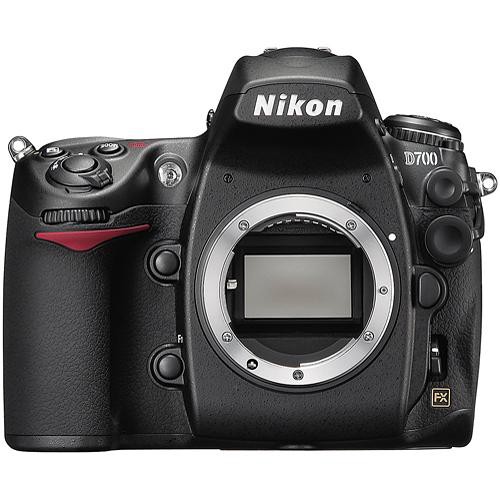
The Nikon D700 was the first consumer-oriented FX camera in Nikon’s lineup. It has next to none of Nikon’s modern features (video, touchscreen, dual card slots) but actually remains a good purchase for a certain segment of photographers.
Specifically, the D700 only shoots 12 megapixel photos, but it sports Nikon’s 51-point autofocus system and 8 FPS with Nikon’s battery grip (5 FPS without). Considering that it sells used for about $400, it’s a surprisingly good deal for sports and portrait photographers on a budget even today.
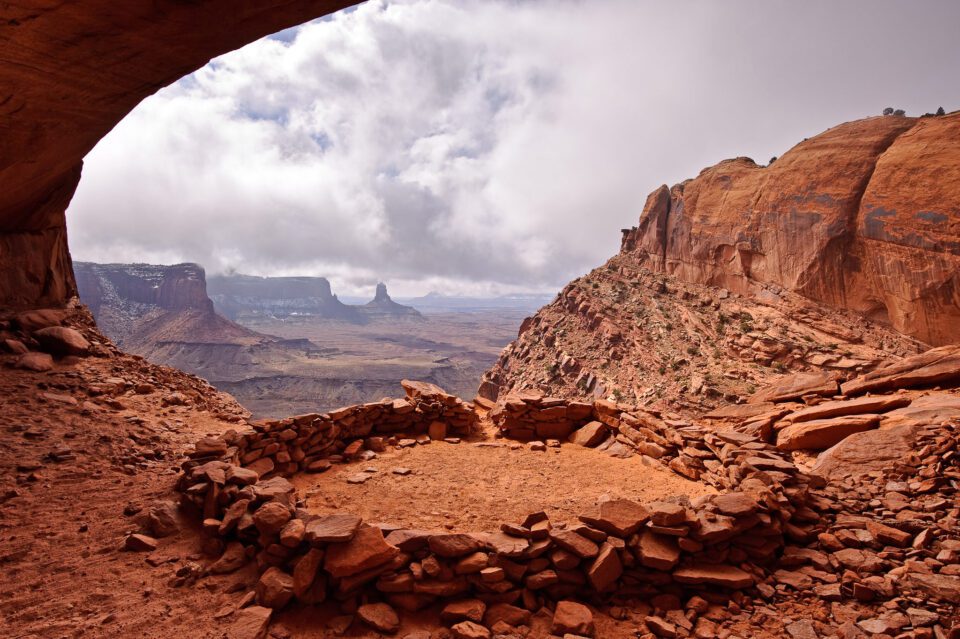
Nikon D800/D800e
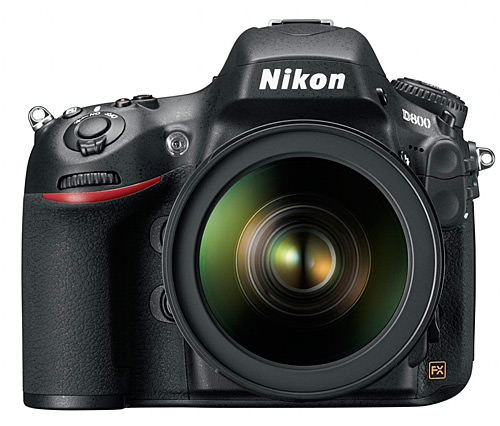
Nikon created a huge splash on the market when it announced the Nikon D800 and D800e in February of 2012 – the first full-frame camera with 36 megapixels, practically a revolution for detail-hungry landscape photographers.
The D800 and D800e are slow cameras to use. Although they do have Nikon’s 51-point focusing system, they’re limited to 4 FPS shooting (6 FPS when shooting in crop-sensor DX mode with a battery grip). Even the D610 beats those numbers.
But if you’re after an ultra-high resolution sensor on a budget, the image quality from the D800 and D800e is amazing even by today’s standards. Used, the D800 is about $550, while the D800e is about $650. (The only difference is that the D800e eliminates the anti-aliasing filter.)
To me, this is a better deal than a used D610 ($700), especially for landscape photographers.
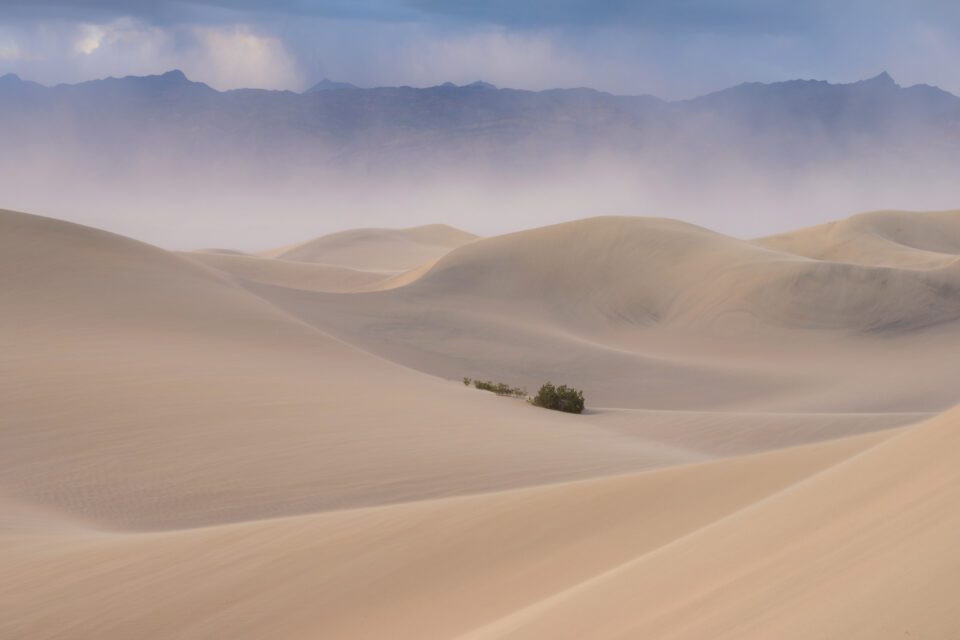
Nikon D810
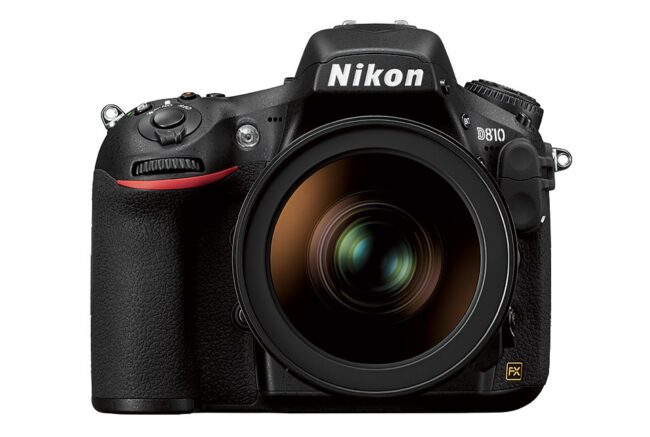
The successor of the Nikon D800, the Nikon D810, is also discontinued.
This full-frame DSLR is just right for a lot of people – especially landscape photographers who want a high resolution camera without spending as much as the D850. Used, you can find it around $1000, which is a seriously good deal for what is basically a modern DSLR.
The Nikon D810 shoots 36 megapixel images at a maximum of 5 FPS (though 6 FPS with a 1.2× crop, and 7 FPS with the battery grip and a DX crop). Although it has a great 51-point autofocus system, it’s more geared toward landscapes than wildlife overall.
Although it isn’t 45 megapixels like the D850 or Z7 II, the image quality on the D810 remains spectacular. The 36 megapixel sensor is more than enough for most photographers, and the D810’s ability to shoot at base ISO 64 rather than 100 gives you some extra dynamic range in high-contrast situations. For the price used, it’s an excellent deal.
Nikon D3
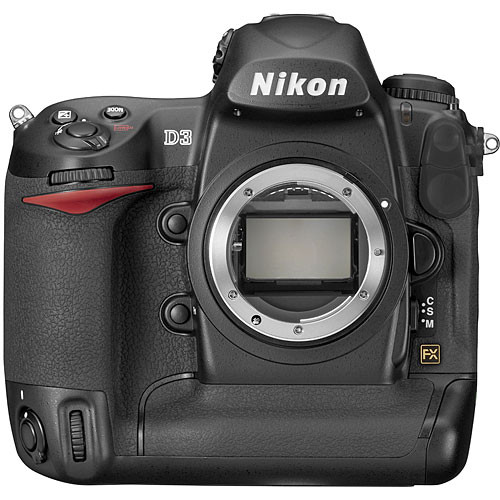
The first-ever full-frame Nikon camera was the D3, announced in August of 2007. Used, it’s in the range of $550.
Like the D700, the Nikon D3 uses a 12-megapixel sensor and Nikon’s 51-point autofocus system. The main benefit of the D3 by comparison is its faster frame rate (9 FPS, or 11 FPS in 5-megapixel crop mode with focusing and exposure locked). However, it is also a significantly larger, heavier camera.
Complicating matters, too, is the D3s – also a 12 megapixel sensor, but one that performs better in low light than either the D3 or the D700. Still, if your budget is around $550 and you want a tough, full-frame, high-FPS beast, the D3 could still be a good buy even 14 years later.
Nikon D3s
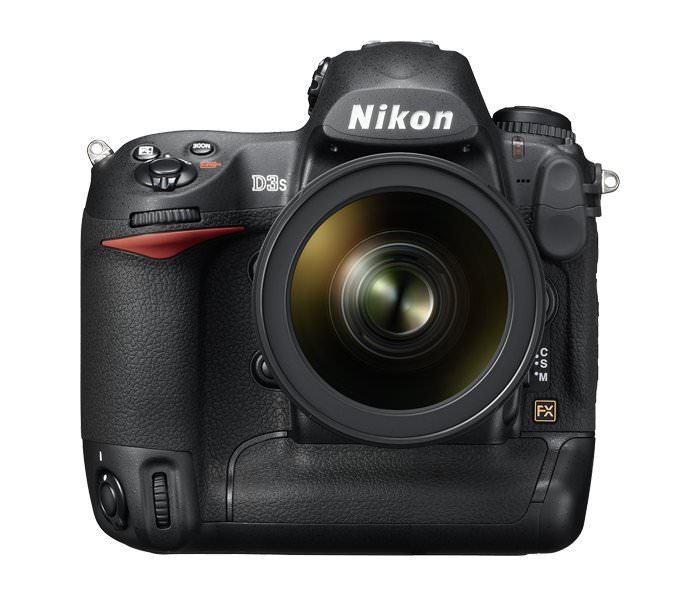
The Nikon D3s matches the D3 in most specifications, but it revamps the 12-megapixel sensor to improve high ISO performance by about 1.5 stops. Even today, the D3s’s high ISO performance is close to the best available, which is amazing considering that it was announced in October 2009.
It’s about $800 on the used market, and – like the D3 – shoots 9 FPS with Nikon’s 51-point focusing system.
Between the D3 and D3s, I’d recommend paying extra for the D3s – or going for the D700 if budget is your main concern. If you have good high ISO performance, 12 megapixels can go a long way.
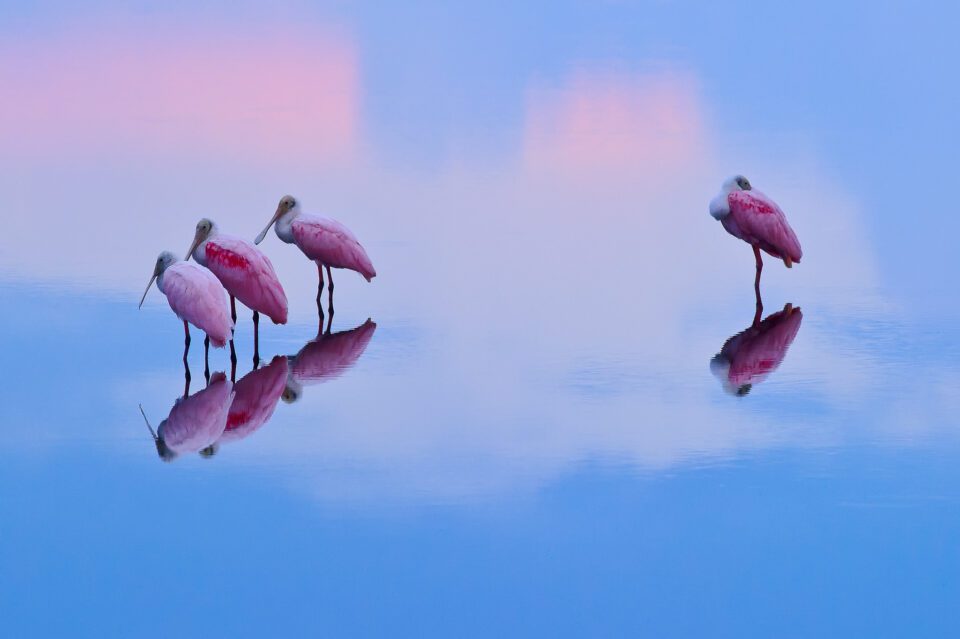
Nikon D3X
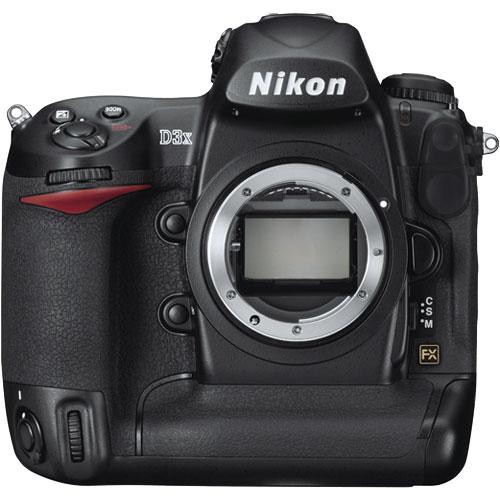
Holding the honor of the most expensive Nikon camera at the time of launch, the D3X sold initially for a whopping $8000. What do you get for the price? Class-leading resolution – 24 megapixels. (All right, class-leading at the time.) Today, it’s about $1000 used.
The D3X maxes out at 5 FPS shooting, again with Nikon’s 51-point autofocus system. So, it’s not geared toward sports and wildlife photography very much; even the D610 shoots faster than that (though with a 39-point focusing system.)
Why would anyone get the D3X today, then? The biggest reason is build quality. Like the other D3/D4/D5 cameras, the D3X is a huge DSLR with an extremely rugged build. If that’s essential for your needs, the D3X is still the highest-resolution camera in Nikon’s lineup with such extreme build quality.
Other than that, it’s a bit of a relic these days. The Nikon D750 is a better camera in every way except build quality, and it costs less on the used market.
Nikon D4
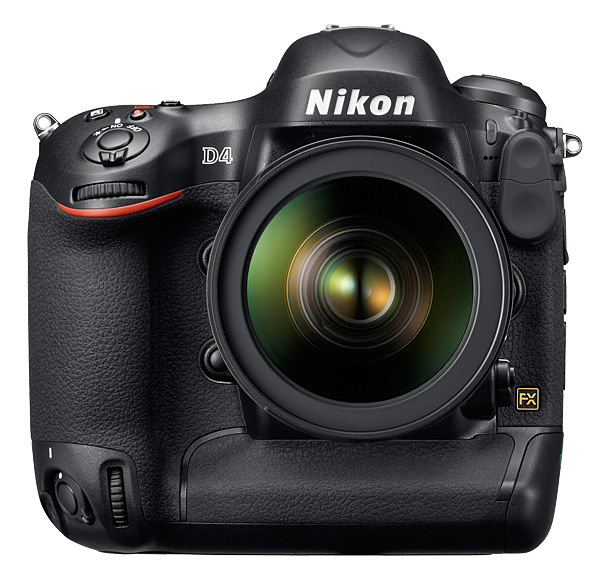
Moving up to the Nikon D4, we have a 16-megapixel sports camera with slightly higher FPS than the D3s (10 FPS natively, 11 FPS with focus and exposure locked).
At a price of about $1200 used, I’d probably lean toward the D4 over the D3s, but it’s a close call. Image quality leans in the D4’s favor because of the higher resolution sensor (and base ISO 100 rather than 200), but high ISO performance is pretty comparable. Both cameras have a 51-point focusing system, though the D4’s is considered the “advanced” version and does track focus a bit better, especially in low light.
We’re kind of spoiled these days. The D4 was announced in January of 2012 for $6000, and today we can get it for 1/5 the price. It remains an amazing camera for sports and action photography.
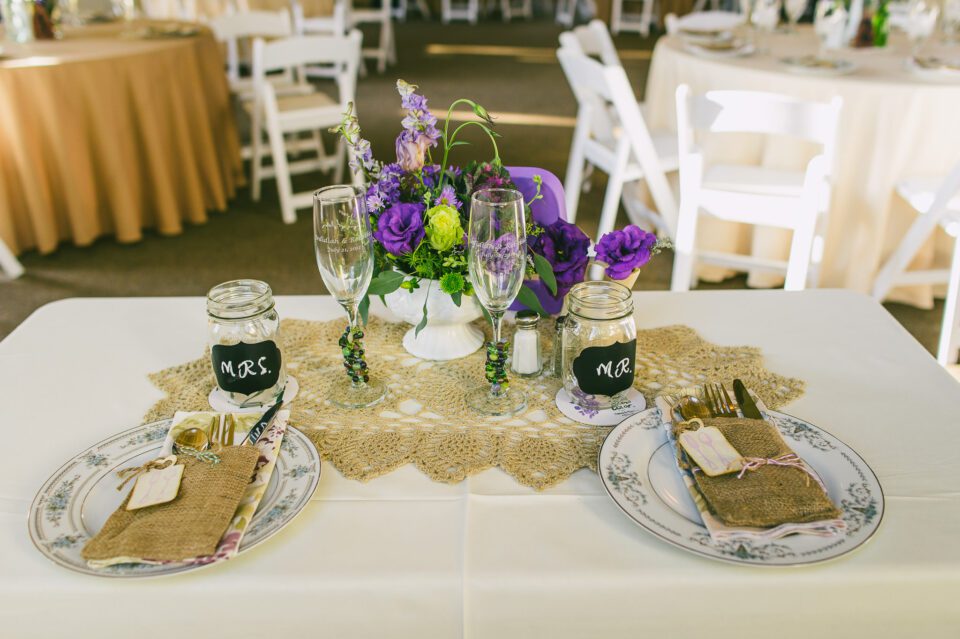
Nikon D4s
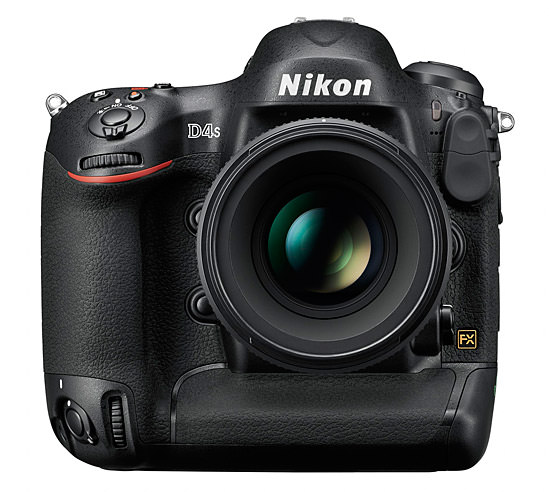
The next-to-last camera on this list is the Nikon D4s, a surprisingly similar camera to the Nikon D4. It adds a group-area autofocus mode, though it doesn’t change the 51-point autofocus system otherwise. The D4s shoots 11 FPS with autofocus and auto exposure (whereas the D4 shoots 10 FPS by comparison).
Also, buffer capacity is a bit better on the D4s – 104 14-bit compressed RAW images versus 76 – although the D4 wasn’t exactly bad in that department. High ISO performance between these two cameras is also essentially the same, with only the slightest improvement on the D4s.
Despite the similarities, it sells for significantly more used – about $1600, though prices fluctuate. For most photographers, I’d recommend sticking to the D4 and spending the money on lenses instead.
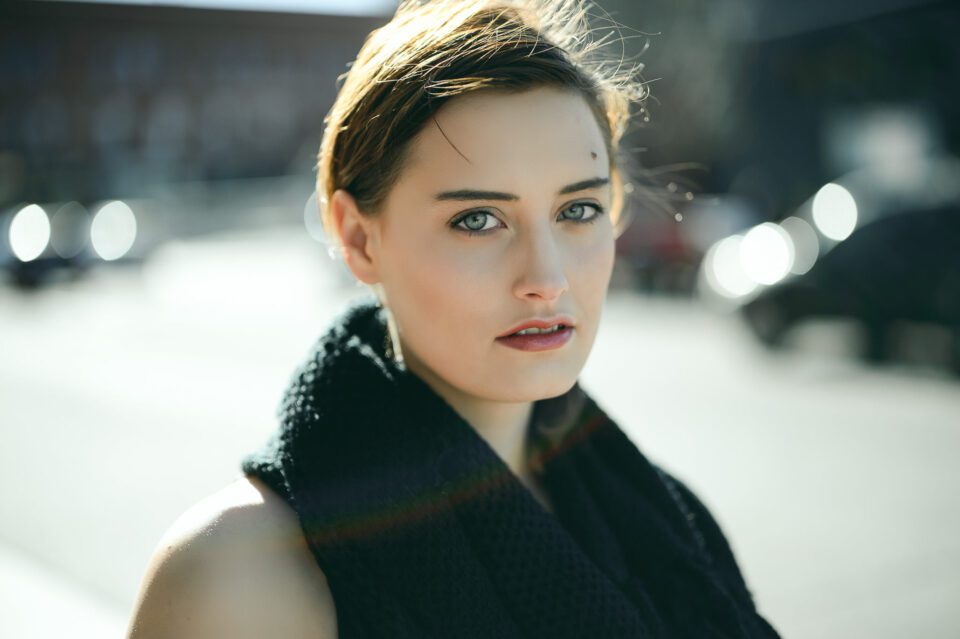
Nikon D5
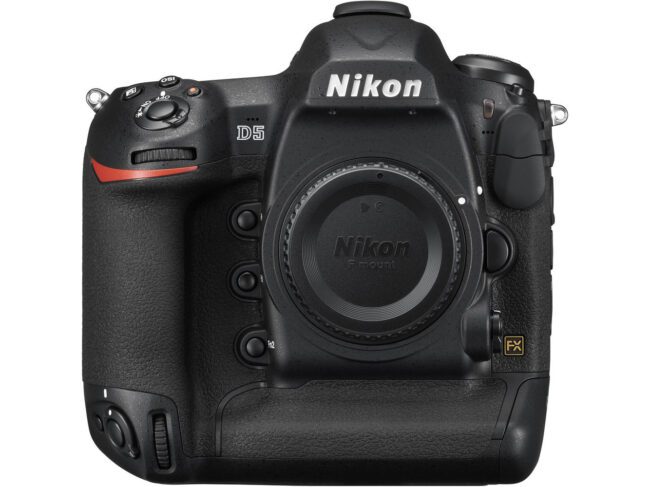
While the D4s may not have been a major upgrade to the D4, the same cannot be said of Nikon’s D5. Even though the D5 is no longer selling new at sites like B&H, it’s still the camera we tend to recommend for high-end sports photographers who want a Nikon camera, given that the D6 is more expensive and doesn’t add too many new features.
The D5 shoots 20.8 megapixel images at 12 FPS, but the biggest upgrade over the D4s is the new autofocus system. The D5 has Nikon’s amazing 153-point autofocus system, making it practically the ideal camera for tracking fast-moving action. It currently sells for about $4000 used, and less if you find one with more than 100,000 shutter actuations (not uncommon for such a pro camera).
It may seem expensive for what you get – on paper, $1500 more than the D850 for lower resolution and just three more FPS – but pros who photograph the Olympics don’t care. The D5’s specifications are unparalleled among Nikon cameras for action photography. And its near-invincible build quality holds up well in almost every environment that isn’t underwater.
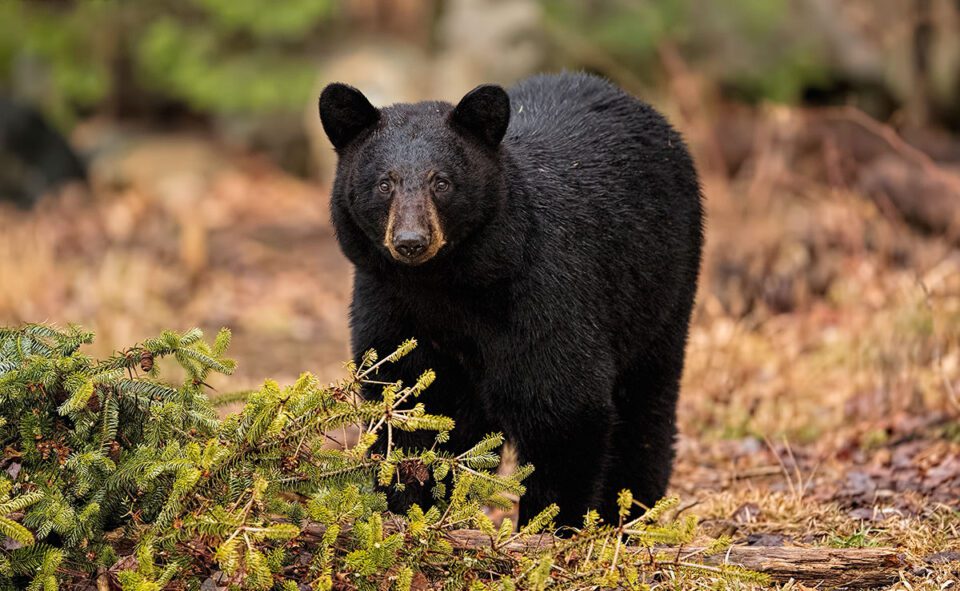
Copyright © Robert Andersen
Conclusion
Nikon has produced quite a number of full-frame cameras over the years, starting with the D3 in 2007 and leading to the current day, with both mirrorless and DSLRs.
There’s hardly a dud in the lineup. Even the D600, the most maligned FX camera Nikon has ever made, is perfectly good when the dust issue is fixed (and an excellent value on the used market as a result).
That said, each Nikon FX camera is made for a different type of photographer, so not all of them will be the optimal choice for you. The D780 is a great all-around budget choice. The D850 is a high-resolution beast. The mirrorless cameras are small, light, and super modern. And many of the discontinued cameras in Nikon’s full-frame lineup remain amazing deals when purchased used today.
This article is not about choosing the “best” Nikon FX camera. Each one could be the best for your needs, or totally unnecessary for the photos you want to take. That’s why Nikon makes so many cameras. Hopefully, this article gave you a good idea of the size and scope of their past and current lineup.
If you have any questions or recommendations about these cameras, please let me know in the comments section below!